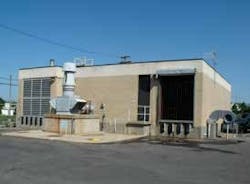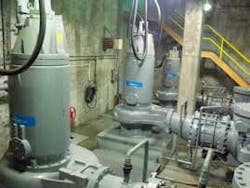Atlantic City (NJ) Sewerage Company (ACSC), a private utility with 7500 connections in and around “The Boardwalk” casino district, keeps a keen eye trained on operating costs. The focus until recently was on the excessive energy and maintenance expense for three, 300-HP long-shaft pumps at the Baltic Avenue Pump Station. The station’s pumps were sized to handle expected growth dealt by the casino industry. When anticipated development fizzled after the initial round of gaming and lodging facilities, ACSC was left with grossly oversized pumps that operated inefficiently and were prone to cavitation which damaged the impellers.
Scope
The Baltic Avenue Pump Station was built with two levels. The Office, MCC and Motor Room are at Elevation 10 while the lower level housing the Pump Room extends down to Elevation -16. The cavernous space inside the building presented a loud, often uncomfortably hot work environment.
“The pump station was built in 1983, approximately 100 feet from a predecessor facility that became the site for the utility’s maintenance garage. When the earlier pump station was designed, the plans called for the three, 300-HP pumps to accommodate expected growth caused by casino development.”
A feasibility study indicated that significant changes to the pumping equipment were required, and the engineering firm suggested changing to submersible pumps in a dry pit configuration. The more advanced units would run quieter, use less energy and generate less heat and their variable frequency drives (VFD) would allow them to operate more efficiently and consume less energy. Equally important, the utility would gain pumps that were also immune to flooding, which was not uncommon given the powerful storms off the Atlantic Ocean.
Solution
After a competitive bid process, ACSC selected the Flygt units over two other pump manufacturers. ACSC replaced a trio of 300-HP long-shaft sewage pumps in the Baltic Avenue Pump Station with more efficient clog resistant Flygt dry pit submersibles manufactured by Xylem.
The first installation included a 135-HP pump sized to deliver 9,600 gpm at 36 TDH, followed by the two 200-HP units that deliver 13,500 gpm at 40 TDH. All included VFDs that balance the operating pump speed with the inflow as measured by the depth held in the wetwell. The larger pumps allow ACSC to stay on a single pump without cycling the lag pumps.
The sizing and engineering features of the Flygt pumps brought the station back into operational balance with the present flows explained Walter Miller, ASCS vice president of operations.
“Compared to the old long-shaft pumps, the Flygt pumps are saving 10 to 30 percent in energy cost and require minimal maintenance.”
Result
The Flygt pumps have reduced overall operating costs and improved the bottom line for the company. They are more appropriately sized for their mission and require inherently less maintenance than the conventional long-shaft pumps they replaced—there are no shafts, packing glands, greasing of universal joints, pinion or steady bearings. Workers are pleased with the noise reduction. Now they can have a conversation at normal volume.
Performing the same mission at half the horsepower of their 300-HP predecessor pumps, the Flygt pumps have delivered a 10 to 30 percent reduction in energy costs for ACSC compared to the previous pumps.
“For us, the Flygt pumps have been the answer and everybody here loves them,” Miller said.
Editor's Note: Scranton Gillette Communications and the SGC Water Group are not liable for the accuracy, efficacy and validity of the claims made in this piece. The views expressed in this content do not reflect the position of the editorial teams of Water & Wastes Digest, Water Quality Products and Storm Water Solutions.

